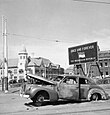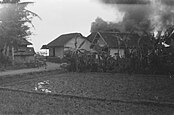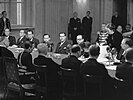| Indonesian National Revolution | |||||||||
|---|---|---|---|---|---|---|---|---|---|
| Part of the aftermath of World War II and the decolonisation of Asia | |||||||||
From top, left to right:
| |||||||||
| |||||||||
| Belligerents | |||||||||
|
Internal conflict: |
| ||||||||
| Commanders and leaders | |||||||||
|
|
| ||||||||
| Strength | |||||||||
| Casualties and losses | |||||||||
| History of Indonesia |
|---|
 |
| Timeline |
|
|
The Indonesian National Revolution (Indonesian: Revolusi Nasional Indonesia), also known as the Indonesian War of Independence (Indonesian: Perang Kemerdekaan Indonesia, Dutch: Indonesische Onafhankelijkheidsoorlog), was an armed conflict and diplomatic struggle between the Republic of Indonesia and the Dutch Empire and an internal social revolution during postwar and postcolonial Indonesia. It took place between Indonesia's declaration of independence in 1945 and the Netherlands' transfer of sovereignty over the Dutch East Indies to the Republic of the United States of Indonesia at the end of 1949.[21]
The four-year struggle involved sporadic but bloody armed conflict, internal Indonesian political and communal upheavals, and two major international diplomatic interventions. Dutch military forces (and, for a while, the forces of the World War II allies) were able to control the major towns, cities and industrial assets in Republican heartlands on Java and Sumatra but could not control the countryside. By 1949, international pressure on the Netherlands, the United States threatening to cut off all economic aid for World War II rebuilding efforts to the Netherlands and the partial military stalemate became such that the Netherlands transferred sovereignty over the Dutch East Indies to the Republic of the United States of Indonesia.[22]
The revolution marked the end of the colonial administration of the Dutch East Indies, except for New Guinea. It also significantly changed ethnic castes as well as reducing the power of many of the local rulers (raja). It did not significantly improve the economic or political fortunes of the majority of the population, although a few Indonesians were able to gain a larger role in commerce.[23]
Cite error: There are <ref group=lower-alpha> tags or {{efn}} templates on this page, but the references will not show without a {{reflist|group=lower-alpha}} template or {{notelist}} template (see the help page).
- ^ Ricklefs, M.C. (2008), A history of modern Indonesia since c. 1200, New York: Palgrave Macmilan, p. 291, ISBN 978-0230546868
- ^ "Indonesian Heritage".
- ^ a b Prastiwi, Arie Mega (15 August 2016). "Kisah Rahmat Shigeru Ono, Tentara Jepang yang 'Membelot' ke NKRI". liputan6.com (in Indonesian). Retrieved 13 May 2020.
- ^ a b Khan, AG (12 May 2012). "Indian Muslim soldiers: heroic role in Indonesia's liberation". The Milli Gazette. Retrieved 24 March 2020.
- ^ "How studying 1945–1949 wars can benefit Indonesia". 1 February 2018.
- ^ "Pasukan Inggris di Indonesia: 1945–1946". 13 November 2020.
- ^ Salim, Emil (2000), Kembali ke Jalan Lurus: Esai-esai 1966–99, Jakarta: AlvaBet, p. 286, ISBN 979-95821-6-4
- ^ "Wie telt de Indonesische doden?". 26 July 2017.
- ^ a b Harinck, Christiaan; van Horn, Nico; Luttikhuis, Bart (14 August 2017). "Do the Indonesians count? Calculating the number of Indonesian victims during the Dutch-Indonesian decolonization war, 1945–1949". Retrieved 14 February 2023.
- ^ Friend 1988, pp. 228 and 237.
- ^ Pendit 1988; Stoler 1985, p. 103; Toer, Toer & Kamil 2005a; Toer, Toer & Kamil 2005b; Toer, Toer & Kamil 2005c; Toer, Toer & Kamil 2014, all cited in Vickers (2005, p. 100)
- ^ a b "Indonesian War of Independence (in numbers)". NIOD Institute for War, Holocaust and Genocide Studies. Retrieved 9 February 2023.
- ^ Kirby 1969, p. 544.
- ^ https://www.militairespectator.nl/sites/default/files/bestanden/uitgaven/1978/1978-0049-01-0020.PDF [bare URL PDF]
- ^ Piccigallo 1979.
- ^ Borch 2017, p. 36.
- ^ "Indonesian War of Independence (in numbers)". NIOD. Retrieved 12 August 2022.
- ^ Kemperman, Jeroen (16 May 2014). "De slachtoffers van de Bersiap" [The Victims of the Bersiap]. Niodbibliotheek.blogspot.com (in Dutch). Retrieved 2 December 2023.
- ^ "The Dark Side of the Revolution of Independence: A Period of Unscrupulous Preparedness".
- ^ https://academic.oup.com/book/9827/chapter/157061044 [bare URL]
- ^ van der Kroef, Justus M. (1951). Ranneft, J. W. Meyer; van Mook, H. J. (eds.). "The Indonesian Revolution in Retrospect". World Politics. 3 (3): 369–398. doi:10.2307/2009120. ISSN 0043-8871. JSTOR 2009120. S2CID 155137141.
- ^ Friend 2003, p. 35.
- ^ Reid 1974, pp. 170–171.





